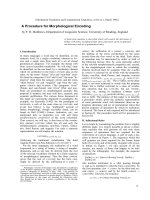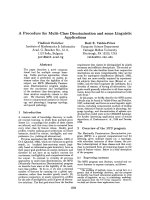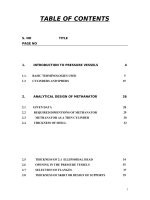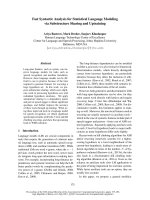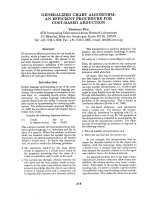acid fast staining procedure for staining mycobacteria
Bạn đang xem bản rút gọn của tài liệu. Xem và tải ngay bản đầy đủ của tài liệu tại đây (362.63 KB, 31 trang )
ACID FAST STAINING PROCEDURE FOR
STAINING MYCOBACTERIA
A Presentation
By
Isaac .U.M.,
Department of Microbiology & Parasitology,
Faculty of Medicine, International Medical & Technological
University,
Dar-Es-Salaam, Tanzania
Introduction
•
Most Mycobacteria grow at a relatively slow rate; therefore, the acid-fast smear plays an
important role in the early diagnosis of mycobacterial infections.
•
Microscopy is the oldest, easiest, most rapid, and inexpensive procedure that can be
performed in the laboratory to detect the presence of acid-fast bacilli.
•
However, the acid-fast smear should not be used in place of culture.
•
AFB smears require 105 AFB/mL of sputum for recognition by direct microscopy; culture
detects as few as 10 to 100 CFU/mL of sputum.
•
In spite of this quantitative discrepancy in sensitivity, examination of stained smears of
sputum, or other clinical material, can be helpful in several ways:
It provides a presumptive diagnosis of mycobacterial disease.
Smear positive patients, the most infectious cases, are rapidly identified.
It may be used to follow the success of chemotherapy of tuberculosis patients.
It is of vital importance to the patient's discharge from the hospital, or return to
employment.
It can confirm that cultures growing on media are indeed acid-fast.
Staining Methods
•
The best known and distinctive property of the genus, Mycobacteria, depends
upon their lipid-rich cell walls which are relatively impermeable to various basic
dyes unless the dyes are combined with phenol.
•
Once stained the cells resist decolorization with acidified organic solvents and
are therefore called ACID FAST.
•
Although the ability to retain arylmethane dyes such as carbol fuchsin and
auramine-rhodamine after washing with alcohol or weak acids is a primary
feature of this genus it is not entirely unique to the genus.
•
Other bacteria which contain mycolic acids, such as Nocardia, can also exhibit
this feature.
•
The exact method by which the stain is retained is unclear but it is thought that
some of the stain becomes trapped within the cell and some forms a complex
with the mycolic acids.
•
This is supported by the finding that shorter chain mycolic acids or
mycobacterial cells with disrupted cell walls stain weakly acid-fast.
Figure 29-1 Mycobacterial cell wall structure. The components include the (A) plasma membrane, (B) peptidoglycans, (C)
arabinogalactan, (D) mannose-capped lipoarabinomannan, (E) plasma-associated and cell wall-associated proteins, (F)
mycolic acids, and (G) glycolipid surface molecules associated with the mycolic acids. (Redrawn from Karakousis et al: Cell
Microbiol 6:105-116, 2004.)
Downloaded from: StudentConsult (on 5 May 2008 05:10 PM)
© 2005 Elsevier
Staining Methods
•
Fluorochrome staining has some advantages and disadvantages over Ziehl-
Neelsen staining.
One advantage is that the smear is examined under a lower magnification
with a dry objective allowing a much larger area of the smear to be
examined in a shorter time.
One of the disadvantages of fluorochrome staining is that organisms
apparently dead, or rendered non-cultivable by chemotherapy may still
fluoresce positive.
This disadvantage is caused by the superiority of the fluorochrome stain
(auramine rhodamine) over the carbol fuchsin stain to bind intensely with
the mycolic acids.
Thus in fluorescence microscopy, more bacilli are stained than would
normally be when stained by the Ziehl-Neelsen method.
Staining Methods
Fluorescent - Auramine Rhodamine Staining
•
STEP 1:
Flame slides to heat fix.
•
STEP 2:
Flood the slide with Auramine Rhodamine stain (BBL, Difco) and allow to stain for 20
minutes.
Be sure that the stain stays on the smear.
Do NOT heat.
Do NOT use paper strips.
•
STEP 3:
Rinse the slide with water.
Auramine-Rhodamine is very "sticky" and should be washed off by "peeling" the stain
off the slide.
Aim the flow of water at the edge of the slide and slowly "peel" the stain from the
slide.
Staining Methods
Fluorescent - Auramine Rhodamine Staining
•
STEP 4:
Flood the slide with 0.5% Acid Alcohol and allow to decolorize for 5 minutes.
Ensure that the slides are flooded thoroughly with Acid-Alcohol.
Continue to add acid-alcohol until NO auramine-rhodamine stain remains visible to
the naked eye.
•
STEP 5:
Rinse off the 0.5% Acid Alcohol with water.
•
STEP 6:
Flood each slide with Potassium Permanganate (MSDS) and allow to quench for 1
minute.
Note: It is critical that the Potassium Permanganate remain on the slides for no longer
than 2 minutes as over quenching of fluorescence can occur.
•
STEP 7:
Wash off the Potassium Permanganate.
Staining Methods
Fluorescent - Auramine Rhodamine Staining
•
If all steps have been completed successfully then your slides when examined
with 25X objective using a microscope that has an HBO L2 bulb heat filter, a BG
12 primary filter, and OG 1 barrier filter should look like this.
Staining Methods
Fluorescent - Auramine Rhodamine Staining
•
This smear is showing over fluorescence of the background of a slide stained
with auramine-rhodamine. The AFB in the smear are fluorescing the same
color as the debris and are blurry, making it difficult to make out the
morphology. Someone inexperienced in the reading of fluorescent smears
might mistake this as being all debris causing a false negative report to be
sent.
Staining Methods
Fluorescent - Auramine Rhodamine Staining
•
Any of the following mistakes during staining can contribute to this occurance:
1. Insufficient washing off of the auramine-rhodamine stain.
2. Insufficient decolorization of the smear because the smear was made too
thick.
3. The slides are not decolorized with acid-alcohol for the required length of
time.
4. Insufficient decolorization due to the slide not being flooded with acid
alcohol until all visible traces of auramine-rhodamine are gone.
5. Insufficient quenching with Potassium Permanganate.
Staining Methods
Fluorescent - Auramine Rhodamine Staining
•
Quality Control Parameters
A positive and negative control slide should be included with each run of
stains.
This will verify the correct performance of the procedure as well as the
staining intensity of the acid-fast organisms.
Control slides should be reviewed before patient smears are read to
confirm that the Mycobacteria stain acid-fast.
If the results of the QC slides are acceptable, go on to the patient smears.
If, however, the control slide(s) are unacceptable, review procedures and
reagent preparations.
When the problem has been identified and corrected, remake and stain all
of the patient's slides from the problem run along with a new set of
controls.
Staining Methods
Fluorescent - Auramine Rhodamine Staining
•
Quality Control Parameters
Staining Methods
Ziehl-Neelsen Staining
•
STEP 1:
Flame slides to heat fix.
•
STEP 2:
Flood the entire slide with Carbol Fuchsin.
Ensure enough stain is added to keep the slides covered throughout the entire
staining step.
•
STEP 3:
Using a Bunsen burner, heat the slides slowly until they are steaming.
Maintain steaming for 5 minutes by using low or intermittent heat (i.e. by
occasionally passing the flame from the Bunsen burner over the slides)
Caution: Using too much flame or heat can cause the slide to break.
•
STEP 4:
Rinse the slide with water.
Staining Methods
Ziehl-Neelsen Staining
•
STEP 5:
Flood the slide with 3% acid-alcohol and allow to decolorize for 5 minutes.
Throughout the 5 minutes, continue to flood the slides with 3% acid-
alcohol until the slides are clear of stain visible to the naked eye.
•
STEP 6:
Rinse the slide thoroughly with water and then drain any excess from the
slides.
•
STEP 7:
Flood the slide with the counterstain, Methylene Blue.
Keep the counterstain on the slides for 1 minute.
•
STEP 8:
Rinse the slide thoroughly with water.
Staining Methods
Ziehl-Neelsen Staining
•
If all steps are performed correctly you should have a slide that looks like this.
Staining Methods
Ziehl-Neelsen Staining
•
This is an example of insufficient staining with Carbol Fuchsin during the Ziehl-
Neelsen staining procedure and/or insufficient flaming of the Carbol Fuchsin
while on the slide. The arrow is pointing to an Acid-fast bacilli that is almost
non-visible. If this step of the staining procedure is not performed correctly
there is a risk of reporting a false negative result.
Staining Methods
Ziehl-Neelsen Staining
•
Quality Control Parameters
A positive and negative control slide should be included with each run of
stains.
This will verify the correct performance of the procedure as well as the
staining intensity of the acid-fast organisms.
Control slides should be reviewed before patient smears are read to
confirm that the mycobacteria stain acid-fast.
If the results of the QC slides are acceptable, go on to the patient smears.
If, however, the control slide(s) are unacceptable, review procedures and
reagent preparations.
When the problem has been identified and corrected, remake and stain all
of the patient's slides from the problem run along with a new set of
controls.
Staining Methods
Ziehl-Neelsen Staining
•
Quality Control Parameters
Examination of Smears for Acid-Fast Bacilli
•
Morphological Characteristics
It is critical to learn the morphological characteristics of mycobacteria since
they are not the only objects that can stain as acid-fast in a smear.
Debris, some species of Nocardia, and some bacterial and fungal spores
can also stain acid-fast.
Acid-fast bacilli range from 1 to 10 µm in length and 0.2 to 0.6 µm in
width.
They typically appear as slender,
rod-shaped bacilli, but they may appear curved or bent.
Individual bacteria may display heavily stained areas referred to as beads
and areas of alternating stain producing a banded appearance.
Some mycobacteria other than M. tuberculosis may appear pleomorphic,
ranging in appearance from long slender rods to coccoid forms, with more
uniform distribution of staining properties.
Examination of Smears for Acid-Fast Bacilli
•
Method of Examination
Ziehl-Neelsen stained smears should be examined with a 54x or 100x oil
immersion* objective; fluorochrome stained smears with a 20x or 40x dry
objective.
Regardless of which type of stain is being observed, each slide must be
thoroughly examined for the presence or absence of acid-fast bacilli.
It is recommended that a minimum of 100 fields be examined before a
smear is reported as negative.
To achieve this, you should adopt a procedure that ensures that a
representative area of the smear is reviewed.
Three passes along the long axis of the slide or nine passes along the
short axis of the slide should provide an ample area for reading and
eliminate the possibility of reading the same area more than once.
Examination of Smears for Acid-Fast Bacilli
•
Method of Examination (Continued …)
Examination of Smears for Acid-Fast Bacilli
•
Method of Examination (Continued …)
If you are reading slides that were made after treatment of a specimen,
and it is determined that acid-fast bacilli are present, then a smear should
also be made from the original untreated specimen, stained by a
fluorescent stain and examined.
AFB should be present, ensuring that a positive report is going out on the
correct patient.
* When reading slides using an oil immersion objective, it is important to
wipe the oil off the objective after reading a positive slide. AFB can
dislodge or float off a slide into the immersion oil and be transferred to one
of the next slides, possibly leading to the reporting of a false positive
result.
Reporting Results of Acid-Fast Bacilli Smears
•
When examining a slide that contains AFB, only observe enough fields to
obtain a representative average of AFB present.
•
Count each AFB that is not touching another AFB as one, and because a
clump represents one colony-forming unit, count clumps of AFB also as one.
•
There are several methods for the reporting of numbers of AFB seen in a
smear.
•
One system recommended by the Center for Disease Control when reporting
fuchsin-stained smears observed at 1000x is:
Reporting Results of Acid-Fast Bacilli Smears
Number of AFB* Seen
Fuchsin Stain (1000 X
Magnification)
Number of AFB Seen
Flurochrome Stain (450 X
Magnification
Report
0 0 No AFB seen
1-2/300 fields 1-2/70 fields Doubtful; request another
specimen
1-9/100 fields 2-18/50 fields 1+
1-9/10 fields 4-36/10 fields 2+
1-9/field 4-36/field 3+
>9/field >36/field 4+
Modified from Kent PT, Kubica GP; Public Health mycobacteriology: a guide for the level III laboratory, US
Department of Health and Human Service, Centers for Disease Control, Atlanta, 1985.
* AFB, Acid Fast Bacilli.
Reporting Results of Acid-Fast Bacilli Smears
• *Since other objects can stain acid-fast (i.e. Nocardia, fungal spores, cellular
debris, etc) a slide should not be reported out as being positive for acid-fast
bacilli unless at least three morphologically correct AFB are seen in the
smear (or per 300 fields). Following this practice reduces the chance of
reporting a false positive result. In an instance where less than three AFB are
seen in a slide it is suggested that you do one or more of the following:
1. Reexamine the smear.
2. Make several more smears from the specimen, stain, and examine.
3. Report the questionable findings to the Doctor and ask that further
specimens be submitted.


